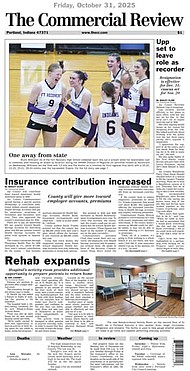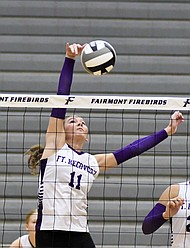October 29, 2020 at 4:52 p.m.
Indiana State Department of Health’s map became a lot more orange Wednesday.
The department increased the number of counties, including Jay, designated as higher-risk locations for coronavirus spread as the state continues to record sharp increases in hospitalizations and new infections.
The state map is color coded, with blue (0 and 0.5 on a three-point scale) for low risk, yellow (1 and 1.5) for intermediate, orange (2 and 2.5) for high and red (3) for severe. Fifty-three of the state’s 92 counties fell in the orange and red ranges as of Wednesday’s weekly update, with Jay County coming in at 2.5. That’s up from 40 last week.
Jay County’s number is highest in the region, though Adams, Blackford, Delaware and Randolph counties were also in the orange range with scores of 2. Wells County was still in the intermediate range at 1.5.
The ratings are based on a combination of a county’s weekly cases per 100,000 residents and its 7-day positivity rate, as measured each Sunday. Jay County had a rate of 278 cases per 100,000 and a 12.4% positivity rate.
The region as a whole saw increased risk.
“If you generally look around the state, we only have three counties in the blue now and a lot more in the orange,” said Heath Butz of Jay County Health Department this morning. “We have a lot of spread going on.”
Indiana Gov. Eric Holcomb had shared similar thoughts during his weekly press conference Wednesday.
“We’re seeing COVID-19 spread in virtually every county,” he said.
“Our hospitals are under a tremendous amount of pressure.”
Jay County was up to 351 cases as of Wednesday state department of health update. There have been 57 new cases in the last seven days, an average of 8.14 per day, showing a continued pattern of an increase in the rate of infection locally.
No single event has been responsible for that increase, Butz said.
“Which means we’re not doing as good a job as we could be doing keeping those numbers down,” he added.
Those measures that can help keep the spread in check include hand washing, social distancing and mask wearing.
“We don’t want to go back on lockdown,” he added.
He said the increase is cause for concern also as fall-like weather has set in, meaning more indoor events. Flu season is also now underway, which causes increased risk of overwhelming hospitals, he added.
More than 100 a day are being admitted to Indiana hospitals with COVID-19 symptoms, said Dr. Kristina Box, Indiana’s health commissioner. Almost 70% of those hospitalized with the coronavirus in Indiana are age 60 or older, she continued, lending to a new statewide effort focused on protecting venerable populations in long-term care settings, like nursing homes and assisted living facilities.
To slow the spread of the virus, more than 1,300 members of Indiana’s National Guard are being deployed to the 133 hardest hit long-term care centers Nov. 3 to assisting with infection control practices like improved COVID-19 testing for facility residents and employees. That support will then expand to all 534 nursing homes in Indiana over the next three weeks. The extra help will be available until Dec. 31.
Holcomb decided a month ago to lift nearly all of Indiana’s restrictions while extending the statewide mask mandate. He announced Oct. 14 another month-long renewal of the mask order until at least Nov. 14.
The governor, up for reelection next week, doubled down on the importance of mask-wearing, which he called “a small price to pay” in order to bring COVID-19 case numbers down, as well as for keeping schools and businesses open.
“We can control only what we can control … Our whole posture is, ‘Let’s be proactive, not reactive,’” Holcomb said Wednesday. “We need individuals to understand that their actions have consequences or their inactions have consequences.”
Indiana’s highest-risk counties are now in the eastern region of the state, including hotspots in Fayette, Dearborn and Ohio counties. Box said the state has recommended that local officials in those counties take steps to control the size of events and establish other “guardrails” to help reduce virus transmission.
Box noted ongoing “challenges” with contact-tracing that could be worsening the statewide spread of COVID-19. The state is seeing an uptick in people who are refusing to answer questions or comply with contact tracers, Box said, as well as families that are neglecting to test multiple people in their homes to avoid quarantines.
“We are seeing an increasing number of people who are just like ‘We’re not going to help you, not going to give you information, not going to quarantine, not going to isolate, we’re just not going to do it,’” Box said. “But it is worth it, and it’s part of what we can do as Hoosiers to try and protect other Hoosiers.”
Coronavirus is spread through respiratory droplets from sneezes and coughs, close personal contact and touching something with the virus on it and then touching the mouth, nose or eyes before washing hands.
The department increased the number of counties, including Jay, designated as higher-risk locations for coronavirus spread as the state continues to record sharp increases in hospitalizations and new infections.
The state map is color coded, with blue (0 and 0.5 on a three-point scale) for low risk, yellow (1 and 1.5) for intermediate, orange (2 and 2.5) for high and red (3) for severe. Fifty-three of the state’s 92 counties fell in the orange and red ranges as of Wednesday’s weekly update, with Jay County coming in at 2.5. That’s up from 40 last week.
Jay County’s number is highest in the region, though Adams, Blackford, Delaware and Randolph counties were also in the orange range with scores of 2. Wells County was still in the intermediate range at 1.5.
The ratings are based on a combination of a county’s weekly cases per 100,000 residents and its 7-day positivity rate, as measured each Sunday. Jay County had a rate of 278 cases per 100,000 and a 12.4% positivity rate.
The region as a whole saw increased risk.
“If you generally look around the state, we only have three counties in the blue now and a lot more in the orange,” said Heath Butz of Jay County Health Department this morning. “We have a lot of spread going on.”
Indiana Gov. Eric Holcomb had shared similar thoughts during his weekly press conference Wednesday.
“We’re seeing COVID-19 spread in virtually every county,” he said.
“Our hospitals are under a tremendous amount of pressure.”
Jay County was up to 351 cases as of Wednesday state department of health update. There have been 57 new cases in the last seven days, an average of 8.14 per day, showing a continued pattern of an increase in the rate of infection locally.
No single event has been responsible for that increase, Butz said.
“Which means we’re not doing as good a job as we could be doing keeping those numbers down,” he added.
Those measures that can help keep the spread in check include hand washing, social distancing and mask wearing.
“We don’t want to go back on lockdown,” he added.
He said the increase is cause for concern also as fall-like weather has set in, meaning more indoor events. Flu season is also now underway, which causes increased risk of overwhelming hospitals, he added.
More than 100 a day are being admitted to Indiana hospitals with COVID-19 symptoms, said Dr. Kristina Box, Indiana’s health commissioner. Almost 70% of those hospitalized with the coronavirus in Indiana are age 60 or older, she continued, lending to a new statewide effort focused on protecting venerable populations in long-term care settings, like nursing homes and assisted living facilities.
To slow the spread of the virus, more than 1,300 members of Indiana’s National Guard are being deployed to the 133 hardest hit long-term care centers Nov. 3 to assisting with infection control practices like improved COVID-19 testing for facility residents and employees. That support will then expand to all 534 nursing homes in Indiana over the next three weeks. The extra help will be available until Dec. 31.
Holcomb decided a month ago to lift nearly all of Indiana’s restrictions while extending the statewide mask mandate. He announced Oct. 14 another month-long renewal of the mask order until at least Nov. 14.
The governor, up for reelection next week, doubled down on the importance of mask-wearing, which he called “a small price to pay” in order to bring COVID-19 case numbers down, as well as for keeping schools and businesses open.
“We can control only what we can control … Our whole posture is, ‘Let’s be proactive, not reactive,’” Holcomb said Wednesday. “We need individuals to understand that their actions have consequences or their inactions have consequences.”
Indiana’s highest-risk counties are now in the eastern region of the state, including hotspots in Fayette, Dearborn and Ohio counties. Box said the state has recommended that local officials in those counties take steps to control the size of events and establish other “guardrails” to help reduce virus transmission.
Box noted ongoing “challenges” with contact-tracing that could be worsening the statewide spread of COVID-19. The state is seeing an uptick in people who are refusing to answer questions or comply with contact tracers, Box said, as well as families that are neglecting to test multiple people in their homes to avoid quarantines.
“We are seeing an increasing number of people who are just like ‘We’re not going to help you, not going to give you information, not going to quarantine, not going to isolate, we’re just not going to do it,’” Box said. “But it is worth it, and it’s part of what we can do as Hoosiers to try and protect other Hoosiers.”
Coronavirus is spread through respiratory droplets from sneezes and coughs, close personal contact and touching something with the virus on it and then touching the mouth, nose or eyes before washing hands.
Top Stories
9/11 NEVER FORGET Mobile Exhibit
Chartwells marketing
September 17, 2024 7:36 a.m.
Events
250 X 250 AD


